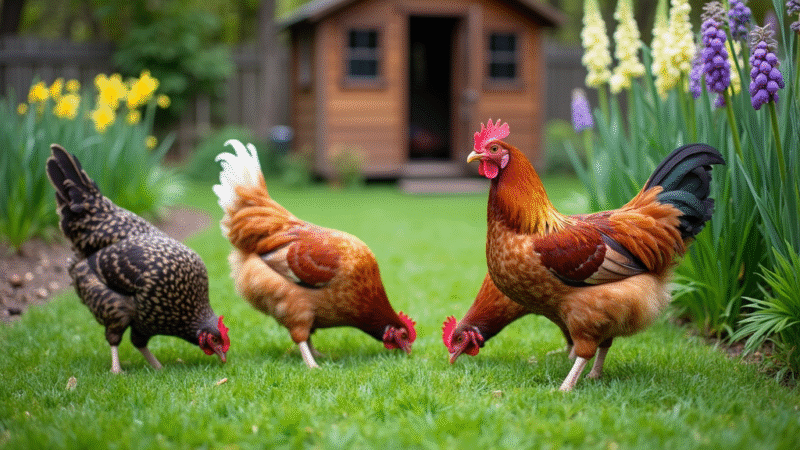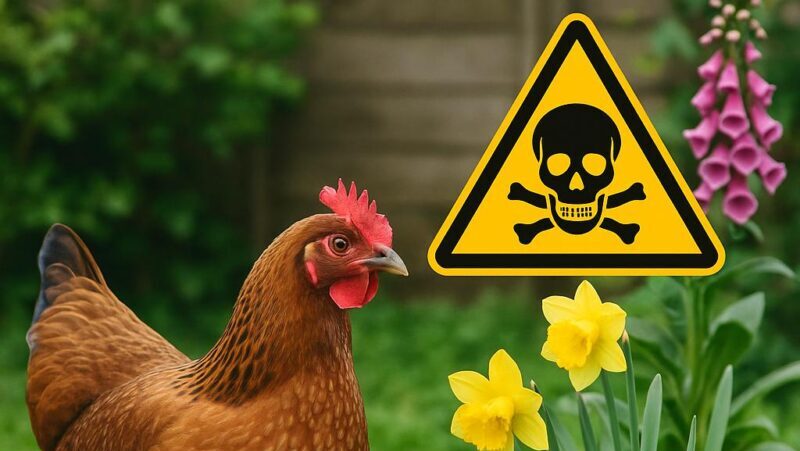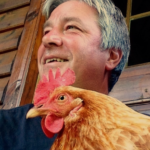Chickens are some of the most curious backyard animals you’ll ever meet. If it grows, wiggles, or moves, chances are they’ll give it a quick peck to see what it tastes like. This curiosity means I need to pay extra attention to what’s growing near the coop. Not every plant in the garden or yard is safe for chickens; some common ornamentals and even veggies pack toxic punches that can leave your flock seriously unwell.

Common Poisonous Plants Chickens Should Avoid
Some plants that look lovely or smell great to us can cause all sorts of trouble for chickens. Many backyard favorites are on the list of things birds shouldn’t nibble. Here are some plants you’ll want to watch out for if you keep chickens free-ranging in the garden:
- Daffodils: Both bulbs and vegetation are very toxic. Daffodils contain lycorine, which can trigger vomiting, diarrhea, and convulsions in birds.
- Foxglove: Known for their beautiful bell-shaped flowers, foxgloves are loaded with cardiac glycosides. Ingesting even small bits can cause heart issues and even death. This goes for people, too!
- Nightshades: This family includes tomato, potato, and eggplant plants (not the ripe fruit). The leaves, stems, green potatoes, and unripened tomatoes all carry solanine, a toxin that chickens can’t handle.
- Lily of the Valley: So pretty in spring, but all parts of this plant contain compounds that can cause a dangerous drop in heart rate.
- Wisteria: Every part of the wisteria vine, from pods to leaves, contains lectins and wisterin. Both are toxic and can lead to stomach upset and more severe symptoms if birds eat enough.
- Rhododendrons & Azaleas: These popular landscape shrubs may look harmless, but they have grayanotoxins, which mess with nerve function in chickens. Even just a few leaves can have a big impact.
- Philodendrons: A common houseplant that can irritate your chicken’s mouth and cause digestive upset because of its insoluble calcium oxalates.
- Oleander, Yew, and Monkshood: These are also very toxic, and in most cases, even a small amount is enough to put a bird’s life at risk.
Elderberries show up a lot on toxic plant lists. This one’s tricky. While my chickens seem happy to snack on the ripe berries, the stems, leaves, and unripe berries are loaded with cyanogenic glycosides, compounds that can turn into cyanide in their bodies. Cooking the berries makes them safe, so if you have elderberries, keep birds away until harvest, and then only let them have the ripe cooked fruit.
Plants Chickens Tend to Dislike (and Why That Matters)
Besides outright poisonous plants, there are a bunch of plants your flock probably won’t touch unless they’re super hungry. Chickens tend to avoid strongly scented, thorny, or tough plants because they’re not appealing to eat. Think of plants like:
- Lavender: The strong scent usually keeps hens away.
- Rosemary: Too resinous for most birds’ tastes.
- Mint: While not dangerous, the flavor and strong aroma aren’t popular with chickens.
- Fern varieties (Bracken in particular): While bracken fern is toxic, chickens usually avoid it naturally because of its taste and texture.
Just because a plant isn’t appealing doesn’t mean it’s safe. Sometimes, chickens will peck at these out of boredom or if other food sources are low. Plus, baby chicks are less picky and can get into trouble faster. It’s better not to rely solely on your flock’s instincts when it comes to plant safety.
Also, keep in mind that some chicken breeds are naturally more curious than others and may sample plants that the rest of the flock ignores. It’s smart to provide plenty of safe options so even the most adventurous hen isn’t tempted by something toxic.
How Toxic Plants Affect Chickens
Symptoms of plant poisoning depend on what plant your chicken gets into and how much they eat. The results can range from mild digestive upset to nervous system problems or rapid decline. Here are a few warning signs I watch for if I suspect a chicken has eaten something toxic:
- Drooling or excessive thirst
- Lethargy or sudden weakness
- Diarrhea or vomiting
- Convulsions or tremors
- Difficulty breathing
- Sudden death (in cases of highly poisonous plants, like yew or foxglove)
Whenever I see these symptoms and suspect plant poisoning, it’s time to act quickly. Separate the sick bird to monitor closely, and reach out to an avian vet for advice. If you’re unsure what the chicken ate, snap a photo of the plants growing nearby for reference. Fast help can make a real difference in recovery, and some toxins require specific treatment, so don’t hesitate to check in with a professional.
Disputed Toxic Plants—Are All the Warnings True?
There’s a lot of chatter in online chickenkeeping communities about whether some plants really are dangerous or just given a bad rap. For example, lambs quarters and alfalfa are often cited as potentially toxic, yet I know plenty of chicken keepers who feed them regularly. Lambs quarters, in particular, are edible for people and birds alike as long as they’re not fed in crazy amounts. It is the one weed I allow to grow in my garden because I use the leaves to add to salads and in place of spinach in omelets.
Still, not every chicken reacts the same way, and not every variety of a plant is equal. Some plants, like elderberry, are super popular but have different levels of risk depending on what part of the plant is eaten and how it’s prepared. When I’m in doubt, I prefer to err on the cautious side and keep those questionmark plants out of the daily forage area. Careful research helps keep backyard flocks safe, and observing flock behavior goes a long way when new plants pop up in the yard.
A Chicken’s Poisonous Plants List

| Plant | Why It’s Toxic to Chickens |
|---|---|
| Amaryllis | Bulbs contain alkaloids causing vomiting and diarrhea |
| Arum lily | Calcium oxalates cause irritation and possible blockage |
| Arrowhead vine | Oxalate toxins irritate mouth, throat, digestive tract |
| Autumn crocus | Contains colchicine—can cause organ failure |
| Avocado | Persin toxin affects heart and breathing |
| Azalea / Rhododendron | Grayanotoxins harm heart and nervous system |
| Blue-green algae | Produces cyanotoxins—liver and nerve damage |
| Boxwood | Alkaloids and glycosides cause vomiting, tremors |
| Castor bean | Ricin causes severe GI distress, often fatal |
| Daffodil (bulb) | Alkaloids cause salivation, vomiting, convulsions |
| Datura (Angel’s trumpet) | Tropane alkaloids cause hallucinations and paralysis |
| Deadly nightshade | Solanine causes respiratory and digestive distress |
| Foxglove | Cardiac glycosides disrupt heart rhythm |
| Hemlock | Coniine causes paralysis and respiratory failure |
| Ivy (English & others) | Causes GI and skin irritation |
| Jimsonweed | Tropane alkaloids cause convulsions and coma |
| Lantana (red sage) | Triterpenoids cause liver damage and photosensitivity |
| Lily of the valley | Cardiac glycosides cause heart issues |
| Oleander | Cardiac glycosides can be fatal |
| Philodendron | Calcium oxalates cause severe mouth and throat pain |
| Poinsettia | Can cause GI upset and drooling |
| Poison hemlock / ivy / oak | Coniine and urushiol cause paralysis and skin rash |
| Pokeweed | Phytolaccatoxin leads to vomiting and respiratory failure |
| Yew (Taxus spp.) | Taxine alkaloids cause sudden cardiac arrest |
| Elderberry | Cyanogenic glycosides produce toxic cyanide |
While this list is by no means all the toxic plants for chickens there are, it should cover most of the ones commonly encountered.
Easy Ways to Protect Your Flock from Dangerous Plants
Preventing plant poisoning is way easier than dealing with a sick flock. Here’s how I keep my birds out of trouble:
- Inspect the Yard Regularly: I do regular walkthroughs every spring and summer. I check for new sprouts, fallen berries, and dropped leaves—anything my birds might peck at. If I’m not sure about a plant, a quick online search or a local extension office call is pretty handy.
- Fence Off Problem Areas: Simple garden fences or netting work well to cordon off dangerous plants like daffodils or shrubs with bright berries. Some folks dig up toxic ornamentals entirely or move the coop to a safer spot just to be sure.
- Keep Chickens WellFed: When birds have good access to proper food, grit, and veggies that you know are safe, they’re way less likely to eat something questionable.
- Offer Boredom Busters: Sometimes, chickens peck at plants simply because they’re bored. Tossing treats (like mealworms or scratch grains), hanging cabbage, or introducing safe weeds can distract them from ornamental plants. You might also add new perches or dustbathing spots to keep them entertained and off the hunt for trouble.
FAQ: Chickens and Toxic Plants
These are some of the questions I hear most often from backyard chicken keepers about plants that aren’t safe for birds.
What’s the most dangerous plant family for chickens?
Nightshades are among the top hazards. They include things like potatoes, tomatoes, eggplants, and peppers (but only the unripe or green parts). Rhododendrons, azaleas, lily of the valley, and foxglove are also repeat offenders because of their toxin content.
Can chickens eat any wild plants safely?
Plenty of wild greens like dandelions, clover, and chickweed are not just safe but also make tasty foraging treats. The key is to get familiar with your local plants, know what’s growing, and keep an eye out for the weeds and ornamentals that need extra caution. Sometimes, learning to identify a few plant groups makes managing risk much simpler, especially when weeds start popping up everywhere after summer rains.
How do I know if my chickens have eaten something toxic?
Look for sudden changes in behavior, droopy wings, messy droppings, or any signs of distress. If you catch a chicken in the act or see plant material in the coop, separate the hen and monitor it closely.
Do chickens learn to avoid certain plants over time?
Many chickens do learn which plants are not tasty or make them feel unwell. Still, young birds and especially bored flocks might try anything once, so it’s always safer to minimize temptation. Offering a variety of safe foods and plenty of space helps set them up for success.
Taking Care with What Your Flock Eats
Watching chickens roam and snack on grass, bugs, and veggie bits is one of the joys of keeping a backyard flock. But the responsibility to keep them safe means paying attention to what’s growing nearby. Some plants are hazardous, and removing or fencing them off is a simple step for peace of mind.
Staying aware of chickensafe plants and doing a little homework whenever you add to your garden means your flock can forage with fewer worries, and you get to relax and enjoy their antics. Making chicken safety a habit always pays off in the long run. When in doubt, check in with experienced keepers or your vet, and err on the side of caution so your backyard flock can thrive.
Enjoy your chickens and have a great day!
Dave

Chickenmethod.com
